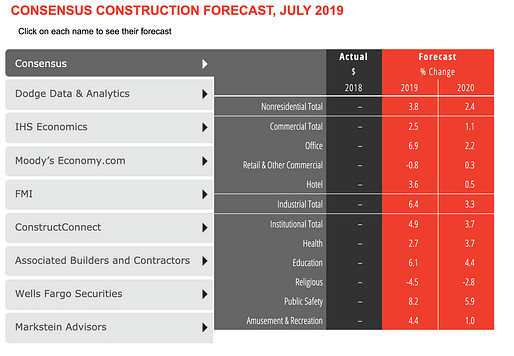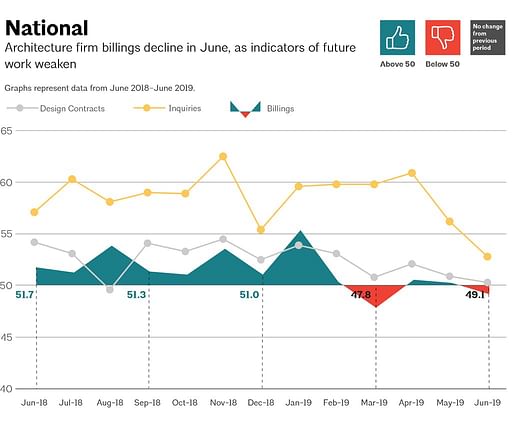
Despite recent warnings from the American Institute of Architects (AIA) of weakening billings numbers among architecture firms, the organization continues to forecast positive economic growth for the construction industry into 2020, with several caveats.
According to AIA's Consensus Construction Forecast, nonresidential construction is poised to grow 3.8-percent this year and 2.4-percent next year over 2018's activity. That relative growth will be led, according to the forecast, by gains in the industrial, educational, public safety, and office sectors.

In a summary of the forecast, AIA chief economist Kermit Baker initially sounds a cautiously optimistic note, saying that the “outlook showing nonresidential construction activity continuing to expand reflects the underlying strength of the economy, even this late in the business cycle.”
But there are concerns for where the economy is headed overall, according to the report, as lagging retail construction points to a "broader slowdown" for commercial construction on the horizon. Over the next 18 months, industrial and institutional sectors could see the strongest growth, as petrochemical, educational, hotel, and office clients continue to expand. (A recent Home Design Trends report showed positive growth in the residential sector).

But the outlook is more "mixed" than "rosy." That's because the odds of a recession taking hold by mid-2020 are rising, according to the report, fueled in large part by President Donald Trump's imposition on trade tariffs, actions that threaten to become "a full-blown trade war." The "dampening" effect of the tariffs on business investment, when coupled with the cost implications for the global supply chain U.S. manufacturers rely on to produce their goods—including building components—spells bad news for the building industry, in particular.
It gets worse: Factors that include weakening business confidence, emerging consumer concerns, and the "limited potential for fiscal or monetary response" from the federal government constitute "potential threats to continued healthy growth in the broader economy as well as in the construction industry that would point to slower economic growth in future quarters.” "Downside risks continue to outweigh upside opportunities," the report warns.
That view is dimmed further by recent softening in the Architecture Billing Index, which "included one fairly significant decline plus other essentially flat monthly readings" since January's high.
AIA's Consensus Construction Forecast, which uses economic forecasts from various investment advisors to create a computed average showing projections for the coming 12- to 18-months, has been consistent, however. AIA's December 2018 forecast also called for increased short-term growth followed by red flags for late-2020.
In that report, Baker writes, “These signals may be temporary responses to negative short-term conditions, but historically they have preceded a more widespread downturn."
No Comments
Block this user
Are you sure you want to block this user and hide all related comments throughout the site?
Archinect
This is your first comment on Archinect. Your comment will be visible once approved.